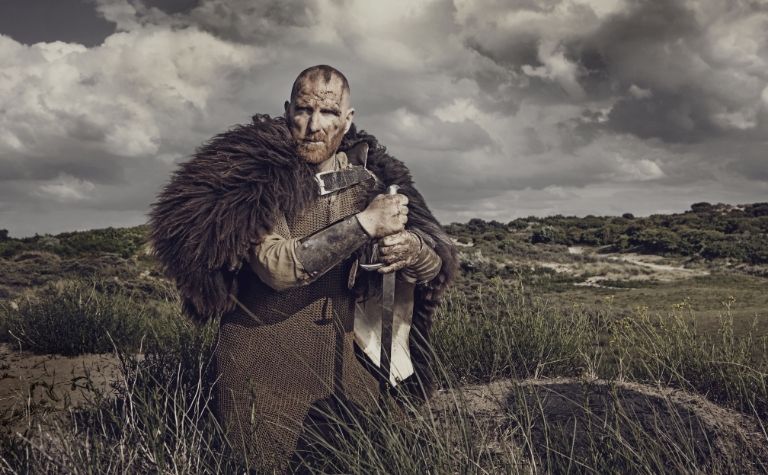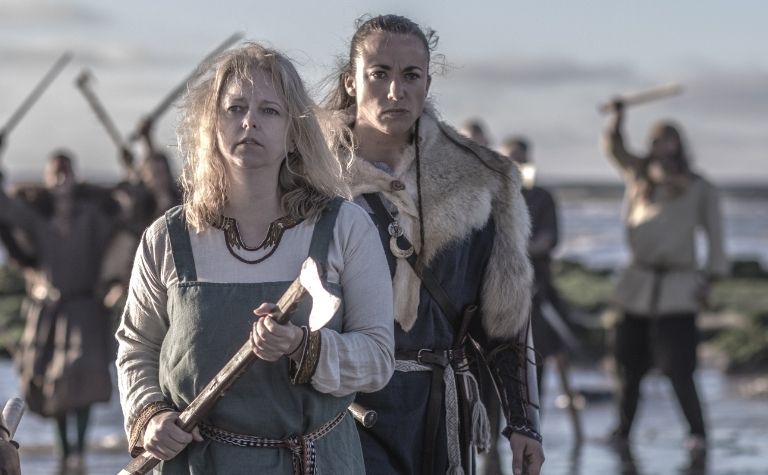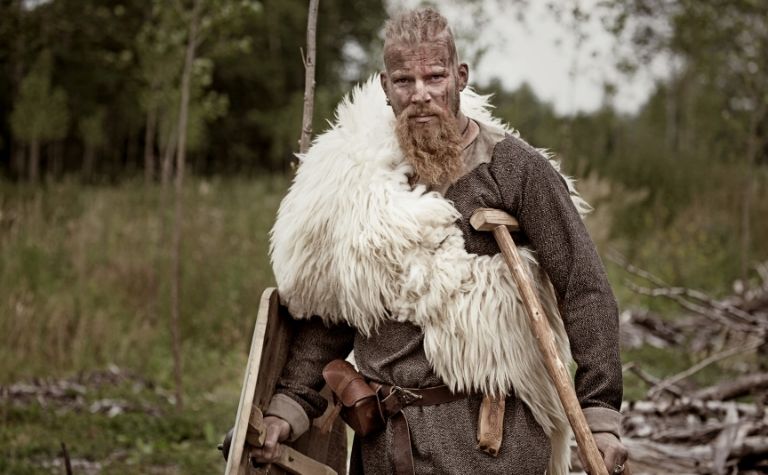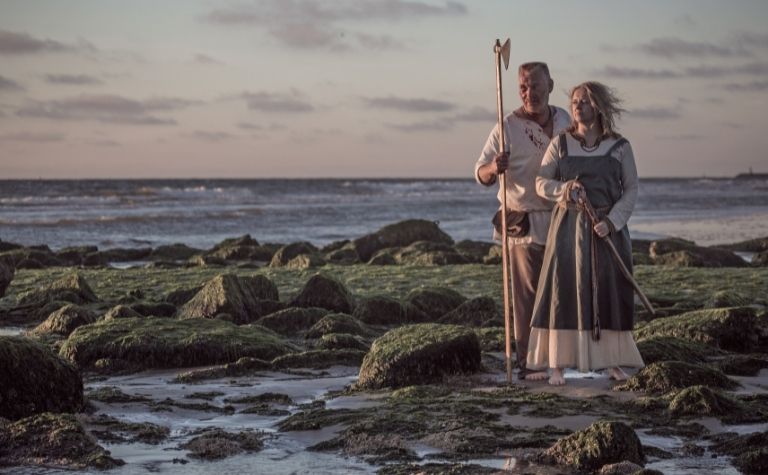Were the Vikings unusually big people? Many people are curious about the Vikings due in part to how they are depicted in popular culture in the 21st century.
Modern stories often depict Vikings as fierce, superhero-like warriors who ruthlessly raid and pillage unsuspecting people.
But was their uniqueness related to their behavior alone or to their physical stature as well?
In general, Vikings weren’t tall by modern standards. According to recent studies on the height of European men in the Middle Ages, the Vikings were 5’8″ to 5’9″ (173.4 centimeters) on average.
However, relative to men in other cultures at the time, the Vikings were above average in height.
What more do recent studies say about the height of the Vikings and other aspects of their physical appearance? What were the factors that determined their height?
Keep reading to learn more.
Are you curious about what the Vikings looked like? See What Did the Vikings Look Like? to learn what scientists believe about their faces, hairstyles, clothing, skin color, and more.

Factors in Viking height
The factors that determined height in Viking culture are the same as factors that determine height in other cultures.
Genetics plays a large role in height, but environmental factors can be significant as well. An article in The Scientific American summarizes the percentages this way:
“The short answer to this question is that about 60 to 80 percent of the difference in height between individuals is determined by genetic factors, whereas 20 to 40 percent can be attributed to environmental effects, mainly nutrition.” [3]
A summary of some of the important environmental factors:
Food is an important factor: Nutrition plays a significant role in a person’s overall health, including physical growth and height.
According to a study done at Ohio State, the Middle Ages period, including northern Europe, the homeland of the Vikings, experienced warmer than average temperatures. (Also see Were There Black Vikings?)
This extended the growing season and increased harvests, providing food for longer periods than previously experienced.
The critical factors in nutrition are protein in childhood as well as vitamins and minerals:
“The most important nutrient for final height is protein in childhood. Minerals, in particular calcium, and vitamins A and D also influence height. Because of this, malnutrition in childhood is detrimental to height.” [5]
Care is an important factor: The availability of healthcare and medicine play a critical role in the overall wellness of people today.
Of course healthcare in the Middle Ages looked much different than it does today, nevertheless, certain helpful factors can be identified.
For example, the availability of certain plants that had medical purposes could contribute to a person’s overall wellness, and affect height. (Also see Did the Vikings Wear Braids?)
Shelter is an important factor: Shelter contributes to the overall wellness of a people group, including their height, because it protects them from the elements.
The Vikings were excellent builders, a skill made necessary by northern Europe’s sometimes challenging environmental conditions.
Their homes, even those they built while traveling, helped them survive rough conditions.
Safety is an important factor: Related to food, care, and shelter, safety is important to a person’s overall health and is a contributing factor to height.
Because the harvests were so plentiful, people did not have to travel to acquire food, which prevented them from being exposed to disease and combat.
For instance, safety from disease is important because disease can hurt a person’s health and stunt their growth.
Additionally, conflict, and the injuries that result from it, can hurt a person’s health and affect their height. (Also see Why Are the Vikings Associated with Axes?)
A lot of people wonder what the Vikings looked like. See How the Vikings Got Tattoos and Why to learn more.

Viking height: recent studies
Recent findings about Viking height are based on studies conducted at Ohio State University in which researchers excavated skeletons in Scandinavia in northern Europe from the time of the Vikings and took measurements of the bones. [2]
The femur, or thigh bone, is especially helpful in estimating height.
“The bones had been excavated from burial sites in northern European countries, including Iceland, Sweden, Norway, Great Britain and Denmark.
In most cases, the length of the femur, or thighbone, was used to estimate skeletal height.
The longest bone in the body, the femur comprises about a quarter of a person’s height.” [1]
All the data the scientists collected enabled them to confidently make conclusive statements about height in that time period.
Like people want to know what the Vikings looked like, they also want to know what they did for fun. See the article, Did the Vikings Play Chess? to find out more.

Increases and decreases in the height of European men
When the water supply, including the sanitation system, improved in Rome, people got taller.
After the Roman Empire, average heights decreased, likely due to the increase of infectious disease and the decrease of healthy drinking water:
The researchers suggest this rise in average height coincided with the Romans’ improved water supply and sanitation systems and a more varied diet at this time.
After the Romans left Britain in 410, heights did not deteriorate immediately but fell from 600 onwards.
The paper highlights previous research suggesting that health may have deteriorated when populations moved out of the towns and cities set up by the Romans, abandoning their more hygienic water supplies and waste disposal systems.
Plague and pestilence then became common and infectious diseases are known to have increased at this time, with archaeological evidence also suggesting that diets were inadequate. [4]
Heights increased again in the Middle Ages, including among the Vikings:
“By the end of the early medieval period, heights had increased to 172 cm, increasing to 173 cm in the 1100s, edging closer to heights achieved at the start of the 20th century.” [4]
Environmental factors were a likely reason:
“A warmer climate may have contributed to good general health among the population, noting that records for 901 until 1100s show that England ‘saw the warmest weather of the millennium’. Over this period of 200 years, average heights increased by more than 5 cm.” [5]
At the end of the Viking period, height started to decrease once more. The farmland may not have been as fertile as it was at the beginning of the Viking age.
Less harvest resulted in less seed, which led to a decrease in crops. Colder temperatures in northern Europe may have been a contributing factor as well. (Also see Do Viking Funerals Still Happen?)
The 14th century Europe experienced periods of famine and, significantly, the Black Death. The lack of food and the increase of disease affected overall wellness, including height.
After the Black Death ended, and agriculture rebounded, overall wellness, including height, increased.
After the time period of the Vikings, the average height of a European man declined for centuries, hitting a low 5’5″ to 5’6″ (167 cm) in the 17th and 18th centuries.
Average heights would not increase again until after the Industrial Revolution in the Western world. (Also see Did the Vikings Worship Odin?)
The Vikings’ wardrobes were functional and fashionable. See The Viking Dress Code: What They Wore and How to find out more.
Poor nutrition affects height
Modern studies have shown that poor nutrition affects the height and this was likely a factor in the height of the Vikings as mentioned above.
“The World Food Program and UNICEF reported last year that chronic malnutrition had left 42 percent of North Korean children stunted — meaning their growth was seriously impaired, most likely permanently.
An earlier report by the U.N. agencies warned that there was strong evidence that physical stunting could be accompanied by intellectual impairment.” [6]

Decline in height after the Middle Ages
Due to various factors, the average of European men fell slightly after the Viking period:
After 1200, heights started to decline, and archaeological evidence shows that at this time, the rural populations were decreasing, farmland had become degraded and there were shortages of crop seeds.
It also notes that other research has suggested temperatures turned colder over the century, with weather becoming far more changeable until the early 1300s.
The early 1300s started with the Great Famine (1315-1317) which may have exaggerated the decline in average heights, but the paper says men had started getting shorter several decades before.
After the Black Death of 1348-1350, however, average heights grew, with the paper noting that this coincided with a boost in agricultural production. [7]
More about Viking appearance
Though the Vikings were similar in height to European men today, their outward appearance was different in many ways as well. (Also see Did the Vikings Have Beards?)
“It’s probably fair to assume that they have been more muscular than we tend to be today, but their appearance was also marked by their hard work. Osteoarthritis was, together with dental problems, a common complaint,” she says.
The Vikings had access to a variety of foods from around the world because they had traveled far and wide as tradesmen and as warriors. [8]
References:
[1] Source
[2] Source
[3] Source
[4] Source
[5] Ibid.
[6] Source
[7] Source
[8] Source
